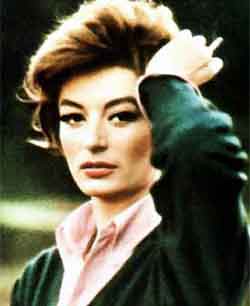Anouk Aimee (b. 1932)

Anouk Aimee is perhaps best known for her remarkable presence as an icon of cool, sophisticated beauty in more than seventy films across seven decades, including such classics as Alexandre Astruc’s Le Rideau Cramoisi (The Crimson Curtain, 1952), Federico Fellini’s La Dolce Vita (1960) and 8 1/2 (1963), Jacques Demy’s Lola (1963), Andre Delvaux’s Un Soir, un Train (One Evening, One Train, 1968), George Cukor’s Justine (1969), Bernardo Bertolucci’s Tragedy of a Ridiculous Man (1981), Robert Altman’s Pret a Porter (Ready to Wear, 1994) and, most unforgettably, Claude Lelouch’s Un Homme et une femme (A Man and a Woman, 1966) opposite Jean-Louis Trintignant—a film that virtually reignited the lush on-screen romance in an era of skeptical modernism …
Her striking features are known to many who have never seen her films. The much-vaunted comparison with Jacqueline Kennedy is more than physical; film historian Ginette Vincendeau notes that Aimee’s films “established her as an ethereal, sensitive and fragile beauty with a tendency to tragic destinies or restrained suffering.”
Anouk Aimee was born Francoise Sorya on April 27, 1932 in Paris. Both her parents were actors; her mother, Genevieve Sorya, was not Jewish, but her father, Henry Dreyfus (who used the name Henry Murray professionally), was. There may be some connection to Captain Alfred Dreyfus, but this has never been elaborated. She was referred to variously as Francoise Sorya, Francoise Dreyfus or Nicole Dreyfus until her acting career (begun when she was just fourteen, with a role in Henri Calef’s La Maison sous la mer [The House by the Sea, 1947]) earned her the name by which she is known. At first she was simply Anouk, taken from the character she played in Marcel Carne’s unfinished film La Fleur de l’age (The Flower of the Age); it was the poet Jacques Prevert, writing Andre Cayatte’s Les Amants de Verone (The Lovers of Verona, 1949) specifically for her, who playfully added the symbolic last name that would forever associate her with the affective power of her screen roles.

Press still from La Dolce Vita (1960)
